E-Museum of Pyrographic ArtPortraits and Paintings Hall
|
| - Café Flambé - | - Portraits and Paintings - | - Decorative and Applied Art - |
| - Folk and Traditional Art - | - Antique Art - | - Special Hall - | - Sculpture - |
| - Children's Hall - | - Bookstore and Library - | - Tools and Techniques - |
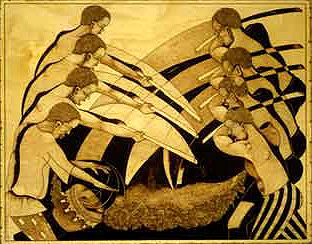 |
M'Batjh (Threshing Grain) by Djibril N'Doye, © 1999 Pyrography on birch wood panel, 24 inches by 19 inches "M'Batjh is one of the most culturally rich times in the work of a rural farmer. When the millet reaches maturity, it is time to separate the grain from the chaff. The harvest is gathered up and left out to dry. The natural drying process can last several weeks. This period provides a sufficient amount of time for the farmer to invite cousins, friends, and neighbors to help out because the manual threshing requires a lot of endurance and very strong arms! The day of "M'Batjh," the harvest is piled high in the middle of the group who form two half-circles. The farmer has cut branches approximately 2 meters long, one for each helper. The leader of the group sings, and, along with the beat of a drummer, the rhythm guides the two groups to hit the grain pile alternately. The work can last a whole day, sometimes longer. The farmer's family who organizes the M'Batjh always prepares and serves a meal for everyone involved. If the season is good, the M'Batjh can produce 1, 2, or 3 tons of grain, which can provide enough for the farmer's family to last 1 or 2 years. "M'Batjh" illustrates the joy of life in a community. All the work is done by "volunteers" who rotate this practice among families." Image and text from the artist's www.djibrilndoye.com website |
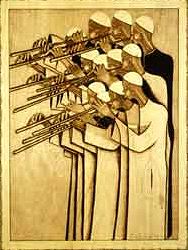 |
Breath Harmony by Djibril N'Doye, © 2001 Pyrography on birch wood panel, 19 inches by 26 inches "Throughout Djibril's life, his grandfather taught him much about many things and gave him great wisdom and guidance. Djibril always reflected on and found comfort in his grandfather's words. There are things in life that we cannot change; they are, in fact, a part of living. One day after having moved to the United States, Djibril phoned his family in Senegal as he often did, but this time was abruptly and uncustomarily given bad news: his beloved grandfather had passed away. Because Djibril found out well after the fact that his grandfather passed on, he was unable to attend any of the traditional memorial ceremonies that were held for him. This drawing is Djibril's expression of both sorrow and grieving for the earthly loss of his grandfather, particularly in Djibril's absence, and the most prayerful, harmonious accompaniment to the afterlife." Image and text from the artist's www.djibrilndoye.com website |
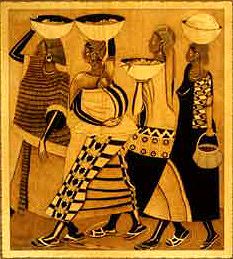 |
Le retour du marché (Return from the Market) by Djibril N'Doye, © 2000 Pyrography on birch wood panel, 20 inches by 22 inches "This scene is part of everyday life in Senegal. The daily outdoor market opens; women prepare themselves to go together to the center of town to make their respective purchases for preparing that day's afternoon meal, which traditionally is the biggest hot meal of the day for the whole family. It is an opportunity to observe the rhythm of such daily life. During this time the fishermen are still out at sea, the farmers are working in their fields, and children are studying in school. But after the women return home from the market each day, they begin preparing a meal for which all family members will return home and share in. Watching the women heading back to their homes, their baskets full of ingredients, Djibril finds comfort in the predictability of the rhythm of life and appreciates the pride they have wearing their traditional outfits and showing the beauty and diversity of their hairstyles. " Image and text from the artist's www.djibrilndoye.com website |
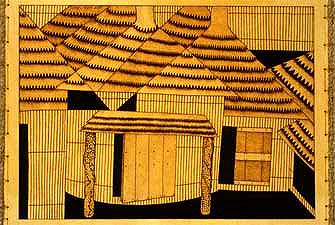 |
Nèguu Niah (Grass House) by Djibril N'Doye, © 2000 Pyrography on birch wood panel, 21 inches by 15 inches "'Nèg' means house. 'Niah' means grass. 'Nèguu niah', therefore, literally means 'house of grass'. Life changes as the times change. The village on the coast of Senegal where Djibril lived has become a city with very different architecture from when he was a child. For economic and environmental reasons, most of the houses are now made of cement. The streets, which were nothing but sand, are now paved. When the city was really a village, all the houses were made with dry grass. Every year as the season changed and new crops came in, neighbors helped each other take down the 'old' grass and each house was made fresh and new." Image and text from the artist's www.djibrilndoye.com website |
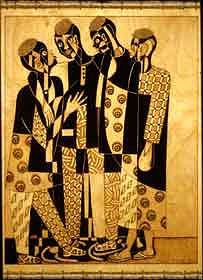 |
N'daw (L'enfance) (Childhood) by Djibril N'Doye, © 2000 Pyrography on birch wood panel, 21 inches by 27 inches "My childhood is a time in life upon which I like to reflect. Here is the anatomy of the life of a child who always loved to draw. My friends like to watch me drawing. I shared my spare time with them and we respected each other a lot. This drawing is a reflection of myself as I look back at my earlier life as a child--knowing how I felt--my thoughts always a bit beyond what my friends may have been talking about right then. I was not necessarily aware of exactly what my artistic sensibilities would bring at that time. Nor did I understand how rich my social and cultural experiences were to contribute to my life as an adult and being a self-taught, professional artist." Image and text from the artist's www.djibrilndoye.com website |
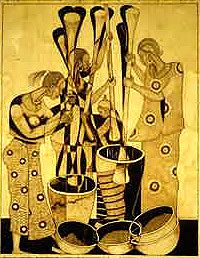 |
Walouwaye (Pounding Millet) by Djibril N'Doye, © 1999 Pyrography on birch wood panel, 19 inches by 26 inches "Everywhere in this world, people talk about modern technology but they never talk about the potential destructive effects of 'modernizing' and technology. Some of the richest traditions Djibril experienced while growing up in his village, where he was always inspired and educated, are affected by modernization. During his youth, he would wake up every morning with the sunrise, aided by the rhythm of 'Walouwaye': the pounding of the millet for the day's meal. Each household has an area reserved for storage of the grain, and the women go there day after day to prepare the flour. 'Walouwaye' represents a place and a time for women to gather to work, but also to chat amongst themselves, share 'secrets', seek advice and comfort. When a family 'upgrades' and spends money to have one of its members (a female) take the grain by herself to be ground quickly by a machine, she loses that special time of bonding and kinship." Image and text from the artist's www.djibrilndoye.com website |
Pyrographic artist Djibril N'Doye born in Senegal in 1953, has been living in the United States since 1995.
In addition to his pyro works, ballpoint pen works, and charcoal works, are a biography and artist's statement on the Djibril N'Doye Website.
Djibril N'Doye's story and more examples of his works were featured in Pyrograffiti 26 in the November–December 2003 issue of WOM.
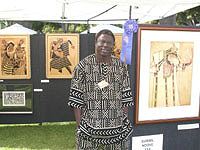 Djibril N'Doye Djibril N'DoyePosing with his blue ribbon at the 2003 "Affaire in the Gardens" Art Show |
As the Pyrograffiti article was going to press and this salon about to open, news came in that Djibril had just been awarded the First Place Blue Ribbon for the category of 'Drawing, Prints & Graphics' at the "Affaire in the Gardens" 30th Anniversary Art Show held in Beverly Hills last month. The winners are on view as follows at the: City of Beverly Hills website. The show featured art by more than 200 exhibitors from around the nation, who showcase their work in photography, painting, sculpture, watercolor, mixed media, ceramics, jewelry, drawings, graphics and prints. Held each May and October since 1973, the "Affaire in the Gardens Art Show" is one of the most popular art events on the West Coast. |
Djibril N'Doye's 2016 Solo Exhibition in Arcadia, California, U.S.A.
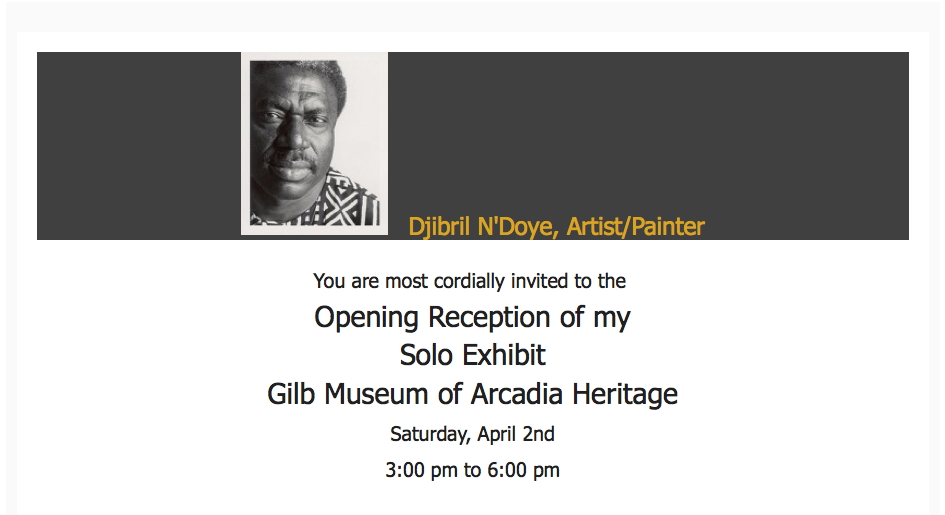 |
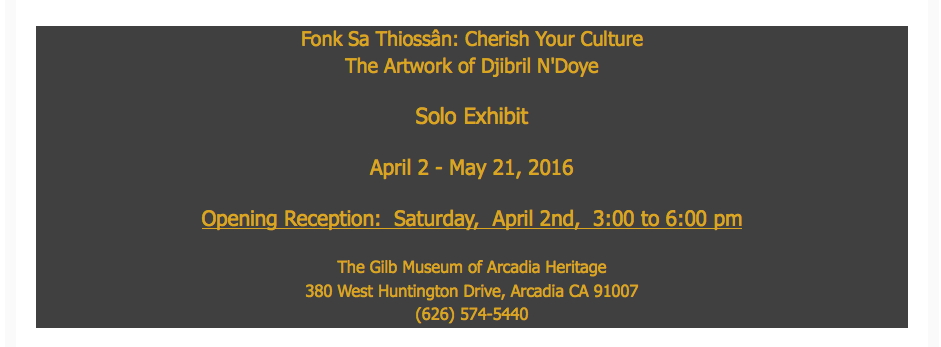 |
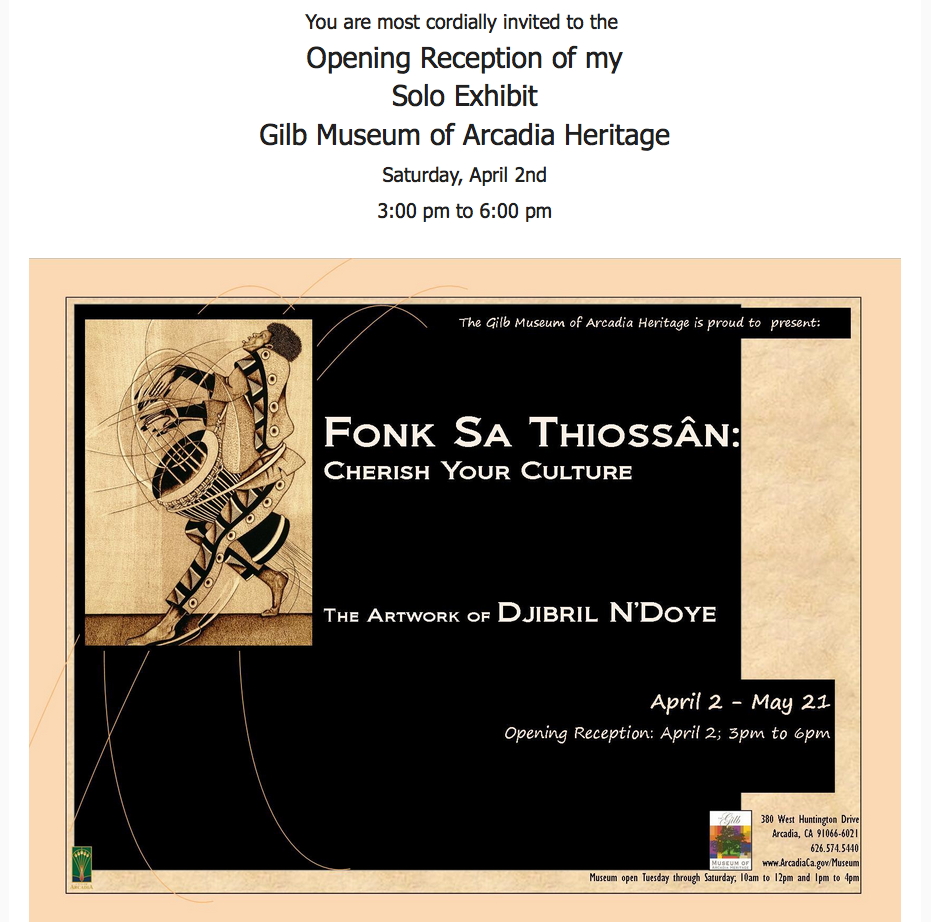 |
If you are going to be anywhere near the Los Angeles, California, area from April until May 21st, be sure and visit Djibril N'Doye's extraordinary exhibition at the Gilb Museum in Arcadia. The curator of the E-Museum had the great privilege of seeing about ten of his works some years back near Leesburg, Virginia. I cannot say enough wonderful things about his vibrant, rhythmic works. |
You are leaving the Djibril N'Doye Salon.
You can return to the
Portraits and Paintings Hall
or visit one of the following:
Pyrographic Art Exhibit Halls:
Decorative and Applied Art
Sculpture
Traditional and Folk Art
Antique Pyrography
Children's Pyrographic Art
Special Pyrographic Art
The Book Store and E-Museum Library
Pyrography Tools and Techniques
Your questions and comments are welcome and appreciated.
Please e-mail the E-Museum Curator
Back to E-Museum Entrance homepage
© 2003, 2009, 2016 Kathleen M. Garvey Menéndez, all rights reserved.
Updated 25 October 2009. Last updated 2 April 2016.

